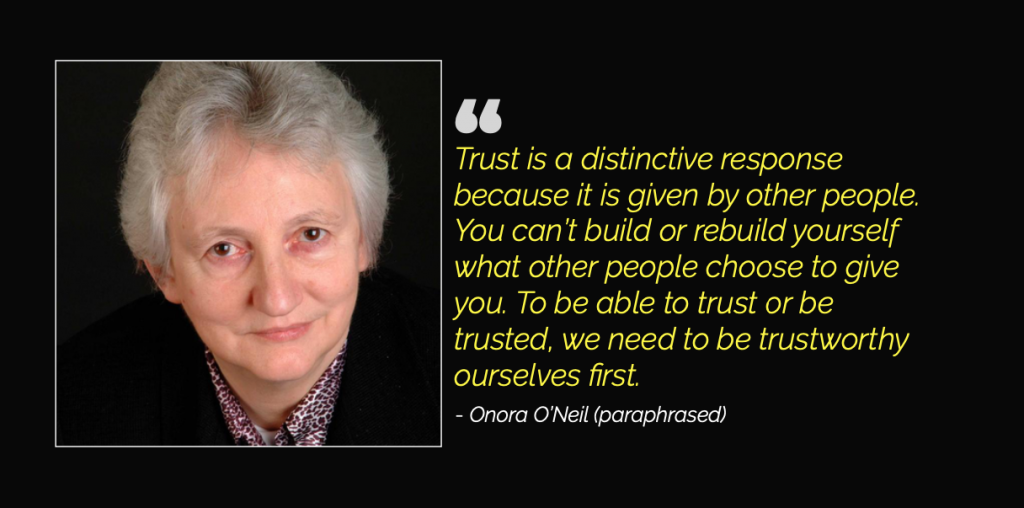Humans are social beings, meaning we require social connection and other people to function. We have been forming different relationships with other human beings to nurture the social connection and live cohesively. And the basis for this relationship comes from one fundamental core – TRUST.
Since many years, trust has been a part of research in wide array of fields – psychology, human behaviors, social neuroscience, behavioral economics, and so on. There have been numerous models and hypothesis about trust and it’s anatomy, but one thing that has remained common is that trust is one of the key components of our social lives.
EXISTING TRUST MODELS
There are 3 elements of trust – positive relationships, good judgement/expertise, and consistency – according to Harvard Business Review author duo Jack Zenger and Joseph Folkman. Frances Frei’s TED Talk also gives insight about the trust triangle – focusing on similar three elements of trust. Frei’s trust triangle spreads across authenticity (I experience the real you), empathy (I believe you care about me and my success), and logic (I know you can do it; your reasoning and judgement are sound).
Professor Dan Ariely’s paper, The Trust Factory, elaborates about five different trust generators – i) The long game: established relationships, ii) The glass door: transparency, iii) The why factor: intentionality, iv) The counterpunch: revenge, and finally v) The common goal: aligned incentives.
James H. Davis, professor of strategic management and the chairman of the Management Department at Utah State University, talks about the three ingredients of building trust – ability, benevolence, and integrity. Ability is when you are able to do what you say you can do. Benevolence is the kindness and wanting to do good for the other person. Finally, integrity is when you say you’re going to do it, and you do it.
BUILDING TRUST – or – BEING TRUST WORTHY?
Trust empowers us and we can empower others by trusting them, says Anne Böckler-Raettig on her TEDxFrankfurt speech. She further explains about how trust is indispensable for humans to establish, maintain, and repair relationships.

But how do we build trust? Baroness Onora O’Neil calls trust as a distinctive response because it is given by other people. So how can we build (or rebuild) something that others give us? Baroness O’Neil vouches us to focus on being trustworthy first. Trust, then, is a response to the trustworthiness.
So how do we become trustworthy? Here’s how:
THE “BRAVE” MODEL OF TRUST
This BRAVE model of trust is a spin off of Dr. Brene Brown’s description about anatomy of trust. Foremost, to be trustworthy ourselves, we need to be brave and build courage. The BRAVE model is elaborated as:
BELIEF
This is the common and shared belief, on which the trust rests. As humans, we have a certain belief system and anyone who steers outside our belief system will be deemed as untrustworthy. Similarly, if our belief system matches with the other person’s belief system, the increase in our trustworthiness is more likely. These belief could be based on our personal values, expertise, experience, knowledge, skills, or attitudes. We might say, “I don’t trust XYZ with my laptop but I can trust him/her with stock market insights”. This goes on to mean that their expertise and experience on the subject matter is a common belief, based on which we can trust the person.
RELIABLE
Being reliable is about consistency in delivering. Our trustworthiness increases when we can consistently deliver (output/results). However, it is understood that our energy levels and performances might not always be consistent. In such regards, we can increase or keep our trustworthiness by being transparent of our actions and taking accountability of the results. We are more likely to trust people and organizations that consistently delivers outputs and takes accountability with transparent and logical actions.
ALTRUISTIC
Displaying selfless concern, and sacrificing our self-interest is another way to increase out trustworthiness. This example comes from Dan Ariely – “Imagine you and your friends are going to lunch, and order fish. The waiter recommends you to go for chicken instead, because the fish has gone stale and chicken is cheaper as well. Now imagine that in the same condition, the waiter recommends you to go for lobster, which is a little expensive than your current order.” In both cases, the waiter displayed selfless concern, but only in the first scenario, the waiter sacrificed their self-interest of earning more revenue. Here, we are more likely to trust the waiter in the first scenario than the second.
VULNERABLE
“Being vulnerable is a good evidence that you are trustworthy”, says Onora O’Neil. Being vulnerable in terms of trust means opening ourselves to other. This opening up helps us connect with people, and become trustworthy. Odin Halvorson shares the importance of being vulnerable, and claims that there are practical benefits in connecting with people, even in circumstances where we might believe it to be pointless or detrimental. As leaders, parents, or even entrepreneurs, we would want other person (subordinates, children, employees) to feel safe and share their problems and mistakes. When they share about their mistake, we have a better chance at solving them. For this, as leaders, the burden of creating the psychological safety falls under our own shoulders.
EMPATHY
Empathy is the ability to understand and share the feelings of the other person. In the case of trust, empathy also means to see the other “person” as “person”. This means to take into account their needs, objectives, fears, challenges as well when we interact with them. This further means an impartial observation of facts, without jumping into trap of judgement. As author-duo Liz and Mollie perfectly illustrates, “when we fail to assume good intentions or admit that we might have jumped to conclusions, we can make emotional mountains out of molehills.” Differentiating facts from feelings, and observations from evaluations would be the key to building empathy, and thus increase our trustworthiness.
This BRAVE model – thus – focuses on increasing our own trustworthiness, and is likely to be helpful in building or rebuilding trust with our partners, co-workers, or any other human beings we interact with.
Also read: Will we be able to trust people the same way?




